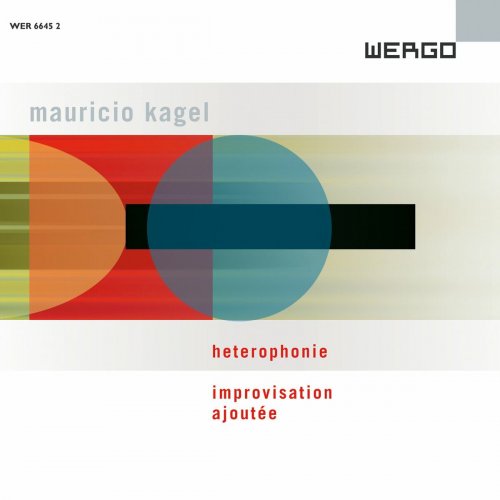
Radio-Sinfonie-Orchester Frankfürt - Kagel: Heterophonie / Improvisation ajoutée (2023)
BAND/ARTIST: Radio-Sinfonie-Orchester Frankfürt
- Title: Kagel: Heterophonie / Improvisation ajoutée
- Year Of Release: 2001/2023
- Label: Wergo
- Genre: Classical
- Quality: FLAC (tracks)
- Total Time: 49:29 min
- Total Size: 180 MB
- WebSite: Album Preview
Tracklist:
01. Heterophonie: I
02. Heterophonie: II
03. Heterophonie: III
04. Heterophonie: IV
05. Heterophonie: V
06. Improvisation ajoutée
01. Heterophonie: I
02. Heterophonie: II
03. Heterophonie: III
04. Heterophonie: IV
05. Heterophonie: V
06. Improvisation ajoutée
This Wergo disc contains two historical recordings of the compositions that helped Argentine composer Mauricio Kagel establish his reputation shortly after he arrived in Germany, the orchestral Heterophonie (1959-1961) and Improvisation ajoutée (1961-1962). These recordings are historic, although they are the only ones made of either work, as they feature artists who mounted the first successful performances of these highly experimental pieces in recordings made close to the time of those events. As sound recordings, both Heterophonie and Improvisation ajoutée behave like "historics" as they haven't necessarily worn the years well; Heterophonie, from 1967, is a little flat and grainy sounding, like used sandpaper, and demonstrates the tell-tale sign of overenthusiastic limiting in that very sudden swells in the music are tampered down by an unseen hand, most likely a compressor. The Improvisation ajoutée recording is better, though Wergo simply could not capture the sound of a pipe organ in 1966 with the kind of fidelity possible in the digital era. Therefore, that's the bad news, but everything else about this recording is good news. Improvisation ajoutée calls for organ and two assistants who work and rework stops while the organist is playing, which results in a crazy quilt of registration and sudden shifts in the tonal color of the instrument: the title literally means "added to improvisation," but can also be taken to mean "assisted" or "adjusted improvisation." The assistants, roles taken here by composers Yngve Jan Trede and Juan Allende-Blin, also contribute cackling laughter and howling worthy of demons, and, along with Gerd Zacher's free-spirited, mad organist-styled virtuosity, this is the perfect soundtrack for a haunted house. Even those with no interest in Kagel or contemporary music should seek it out for that. Heterophonie, or "heterophony," refers to a practice typical in indigenous music where several instruments play an identical musical line and a sense of haphazard polyphony results from the widely ranging tone colors that result. Kagel's score provides individual lines of musical actions for related groups of orchestral instruments, but not the specific pitches or registers, at least not for the whole score, and some sections for fully composed. Likewise, the five different sections of the work can be shuffled around in order. As the piece leaves so much for the players to work out on their own, one could imagine it would be difficult to coordinate, and indeed, the premiere in Cologne in 1962 was a disaster that in the short term proved more harm for Kagel's reputation than good. However, Michael Gielen revived the piece with the Frankfurt Radio Symphony in 1967, and proved the happy medium through which Heterophonie finally triumphed; this is the performance reproduced here. Gielen's shaping of the material makes dramatic sense; the opening sounds like the orchestra tuning up, yet many stray things are sticking out of the texture. The organ is also a significant element in this work, particularly in the second section where there is a huge organ chord and other instruments well up in the center of it. You would think the music couldn't possibly get more dense or complex, and yet additional layers keep joining the music; it is a provocative and engaging moment. Kagel stood apart from many of the composers in Cologne at this juncture, as he really didn't employ serialism; he had adopted, and abandoned, such techniques already when he was in Argentina. Like John Cage, Kagel was more interested in the actionability of music-making than in negotiating specific pitch choices and in finding a unique framework on which to build them. Such lack of concern naturally leads to a sense of randomness regarding pitch, and the harmonic profile of this music can be dense, clustery, and blocky. However, Kagel's irreverent, free-spirited weirdness is far more interesting and groovy than much of the music coming out of the Darmstadt school in the early '60s.
Year 2023 | Classical | FLAC / APE
As a ISRA.CLOUD's PREMIUM member you will have the following benefits:
- Unlimited high speed downloads
- Download directly without waiting time
- Unlimited parallel downloads
- Support for download accelerators
- No advertising
- Resume broken downloads


